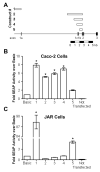Novel promoter and alternate transcription start site of the human serotonin reuptake transporter in intestinal mucosa
- PMID: 19222758
- PMCID: PMC2722877
- DOI: 10.1111/j.1365-2982.2008.01247.x
Novel promoter and alternate transcription start site of the human serotonin reuptake transporter in intestinal mucosa
Abstract
Selective serotonin-reuptake inhibitors are therapies for psychological and bowel disorders, but produce adverse effects in the non-targeted system. To determine whether human serotonin-selective reuptake transporter (SERT) transcripts in the intestine are different from the brain, rapid amplification of cDNA ends, primer extension and RT-PCR assays were used to evaluate SERT transcripts from each region. Potential SLC6A4 gene promoter constructs were evaluated with a secreted alkaline phosphatase reporter assay. A novel transcript of the human SLC6A4 gene was discovered that predominates in the intestine, and differs from previous transcripts in the 5'-untranslated region. The distinct transcriptional start site and alternate promoter suggest that gastrointestinal SERT can be differentially regulated from brain SERT, may explain why the polymorphism in the previously identified promoter is associated with affective disorders, but not associated with gastrointestinal dysfunction, and suggest the intriguing possibility of the development of site-specific therapeutics for SERT regulation in the treatment of multiple disorders.
Figures




Similar articles
-
Epidermal growth factor upregulates serotonin transporter in human intestinal epithelial cells via transcriptional mechanisms.Am J Physiol Gastrointest Liver Physiol. 2011 Apr;300(4):G627-36. doi: 10.1152/ajpgi.00563.2010. Epub 2011 Jan 27. Am J Physiol Gastrointest Liver Physiol. 2011. PMID: 21273531 Free PMC article.
-
Serotonin transporter gene promoter region polymorphisms and serotonin transporter expression in the colonic mucosa of irritable bowel syndrome patients.Neurogastroenterol Motil. 2012 Jun;24(6):560-5, e254-5. doi: 10.1111/j.1365-2982.2012.01902.x. Epub 2012 Mar 21. Neurogastroenterol Motil. 2012. PMID: 22435794
-
Hepatocyte nuclear factor-4α regulates expression of the serotonin transporter in intestinal epithelial cells.Am J Physiol Cell Physiol. 2020 Jun 1;318(6):C1294-C1304. doi: 10.1152/ajpcell.00477.2019. Epub 2020 Apr 29. Am J Physiol Cell Physiol. 2020. PMID: 32348179 Free PMC article.
-
The genetics of the serotonin transporter and irritable bowel syndrome.Trends Mol Med. 2008 Jul;14(7):295-304. doi: 10.1016/j.molmed.2008.05.001. Epub 2008 Jun 10. Trends Mol Med. 2008. PMID: 18550438 Review.
-
A role for the serotonin reuptake transporter in the brain and intestinal features of autism spectrum disorders and developmental antidepressant exposure.J Chem Neuroanat. 2017 Oct;83-84:36-40. doi: 10.1016/j.jchemneu.2017.02.001. Epub 2017 Feb 14. J Chem Neuroanat. 2017. PMID: 28213183 Free PMC article. Review.
Cited by
-
Epidermal growth factor upregulates serotonin transporter in human intestinal epithelial cells via transcriptional mechanisms.Am J Physiol Gastrointest Liver Physiol. 2011 Apr;300(4):G627-36. doi: 10.1152/ajpgi.00563.2010. Epub 2011 Jan 27. Am J Physiol Gastrointest Liver Physiol. 2011. PMID: 21273531 Free PMC article.
-
Regulation of intestinal serotonin transporter expression via epigenetic mechanisms: role of HDAC2.Am J Physiol Cell Physiol. 2013 Feb 15;304(4):C334-41. doi: 10.1152/ajpcell.00361.2012. Epub 2012 Nov 28. Am J Physiol Cell Physiol. 2013. PMID: 23195070 Free PMC article.
-
Serotonin is a sword and a shield of the bowel: serotonin plays offense and defense.Trans Am Clin Climatol Assoc. 2012;123:268-80; discussion 280. Trans Am Clin Climatol Assoc. 2012. PMID: 23303993 Free PMC article.
-
Optimal vitamin D spurs serotonin: 1,25-dihydroxyvitamin D represses serotonin reuptake transport (SERT) and degradation (MAO-A) gene expression in cultured rat serotonergic neuronal cell lines.Genes Nutr. 2018 Jul 11;13:19. doi: 10.1186/s12263-018-0605-7. eCollection 2018. Genes Nutr. 2018. PMID: 30008960 Free PMC article.
-
Modulation of human serotonin transporter expression by 5-HTTLPR in colon cells.Int J Mol Sci. 2011;12(10):6619-34. doi: 10.3390/ijms12106619. Epub 2011 Oct 10. Int J Mol Sci. 2011. PMID: 22072907 Free PMC article.
References
-
- Costedio MM, Hyman N, Mawe GM. Serotonin and its role in colonic function and in gastrointestinal disorders. Dis Colon Rectum. 2007;50:376–88. - PubMed
-
- Vaswani M, Linda FK, Ramesh S. Role of selective serotonin reuptake inhibitors in psychiatric disorders: a comprehensive review. Prog Neuropsychopharmacol Biol Psychiatry. 2003;27:85–102. - PubMed
-
- Spigset O. Adverse reactions of selective serotonin reuptake inhibitors: reports from a spontaneous reporting system. Drug Saf. 1999;20:277–87. - PubMed
-
- Tack J, Broekaert D, Corsetti M, Fischler B, Janssens J. Influence of acute serotonin reuptake inhibition on colonic sensorimotor function in man. Aliment Pharmacol Ther. 2006;23:265–74. - PubMed
Publication types
MeSH terms
Substances
Grants and funding
LinkOut - more resources
Full Text Sources

